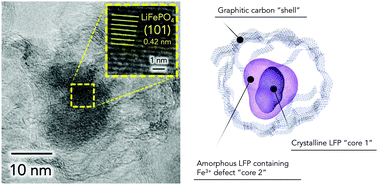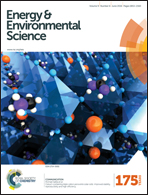Ultrafast charge–discharge characteristics of a nanosized core–shell structured LiFePO4 material for hybrid supercapacitor applications†
Abstract
Highly dispersed crystalline/amorphous LiFePO4 (LFP) nanoparticles encapsulated within hollow-structured graphitic carbon were synthesized using an in situ ultracentrifugation process. Ultracentrifugation triggered an in situ sol–gel reaction that led to the formation of core–shell LFP simultaneously hybridized with fractured graphitic carbon. The structure has double cores that contain a crystalline LFP (core 1) covered by an amorphous LFP containing Fe3+ defects (core 2), which are encapsulated by graphitic carbon (shell). These core–shell LFP nanocomposites show improved Li+ diffusivity thanks to the presence of an amorphous LFP phase. This material enables ultrafast discharge rates (60 mA h g−1 at 100C and 36 mA h g−1 at 300C) as well as ultrafast charge rates (60 mA h g−1 at 100C and 36 mA h g−1 at 300C). The synthesized core–shell nanocomposites overcome the inherent one-dimensional diffusion limitation in LFP and yet deliver/store high electrochemical capacity in both ways symmetrically up to 480C. Such a high rate symmetric capacity for both charge and discharge has never been reported so far for LFP cathode materials. This offers new opportunities for designing high-energy and high-power hybrid supercapacitors.



 Please wait while we load your content...
Please wait while we load your content...